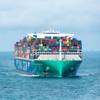Conference Tackles Impact of Shipping on the Environment
Szczecin, Poland - The challenges of preparing to meet the next generation of shipping regulations were very much on the minds of the participants at Germanischer Lloyd's (GL) latest exchange forum in Szczecin, Poland. Reducing the impact of global shipping on the environment and making improvements in efficiency are the focus of looming legislation which, over the next few years, seems certain to change the maritime landscape.
More than 40 representatives from the maritime industry, shipping companies, ship management agencies, maritime journalists and stakeholders met to hear presentations from GL experts and discuss how the incoming regulations would impact upon the industry. Presentations examined the regulations in terms of their implementation, commercial implications, operational and design challenges, and how the shipping community must step up to prepare for their introduction sooner rather than later.
The Ballast Water Convention requires the further ratification of countries representing only 8 percent of global gross tonnage before it will enter into force, said Christopher Peickert, GL's Deputy Head of the Stability Department. Peickert looked at the requirements of the regulation and at the many methods of treatment and systems available to shipowners and builders. Every vessel would need to have a Ballast Water Management (BWM) Plan prepared by a shipyard or design office, he noted.
To aid shipowners, GL has issued a guidance paper for Ballast Water Treatment Systems, and a BWM Model Booklet is also available for GL customers. There are about 40 ballast water treatment manufacturers in the market, Peickert said, and about 10 systems with full certification approval. The majority of manufacturers have designed their systems in modules to serve retrofitting requirements in narrow engine rooms, as well as to cope with the need to treat high volumes when systems can run in parallel assembly.
Peickert looked at the various critical parameters for selecting a system which was appropriate for an individual vessel and gave the attendees an overview of these parameters regarding particular vessel types. The selection of a system was dependent not only on the ship type, but also on the route, he noted, with sea water temperature, salinity, sediment load and the availability of spare parts and the active substances used in a system key factors to consider.
Björn Pape, from GL's consulting subsidiary FutureShip, examined the class and regulatory requirements for the conversion of vessels to utilize scrubber technology. Pape looked at conversions where both wet and dry scrubber systems had been installed. Pape also went on to lay out the process, installation and logistical use of dry scrubber technology, showing how the systems had been integrated into several vessel types and the disposal options for the gypsum which remains as a waste product of the scrubbing process.
The safety considerations, class rules and monitoring requirements were laid out by Pape, who noted that Class rules did not require Wet Scrubber Systems to have a scrubber bypass system, as long as the complete system is made of non-combustible material and that the bypass system may be dispensed with in the event an EGCS is installed on a multi-engine plant. Dry scrubbers, he suggested, may require draft fans in order not to exceed the allowable exhaust gas back pressure, specified by the engine manufacturer for all load cases.
The 62nd session of the Marine Environment Protection Committee (MEPC) of International Maritime Organization (IMO), in particular brought significant changes to the regulatory landscape in shipping with the adoption of the Energy Efficiency Design Index (EEDI) and the Shipboard Energy Efficiency Management Plan (SEEMP). Set to enter into force in 2013, the regulations are designed to spur innovation in both ship design and operation to reduce the environmental impact of shipping on a global level.
With bunker prices having ballooned over the last few years and being predicted to double again over the lifetime of today's vessels, reducing fuel consumption, which accounts for between 30 to 60 percent of total shipping costs, is the key to prospering long term in the industry.













